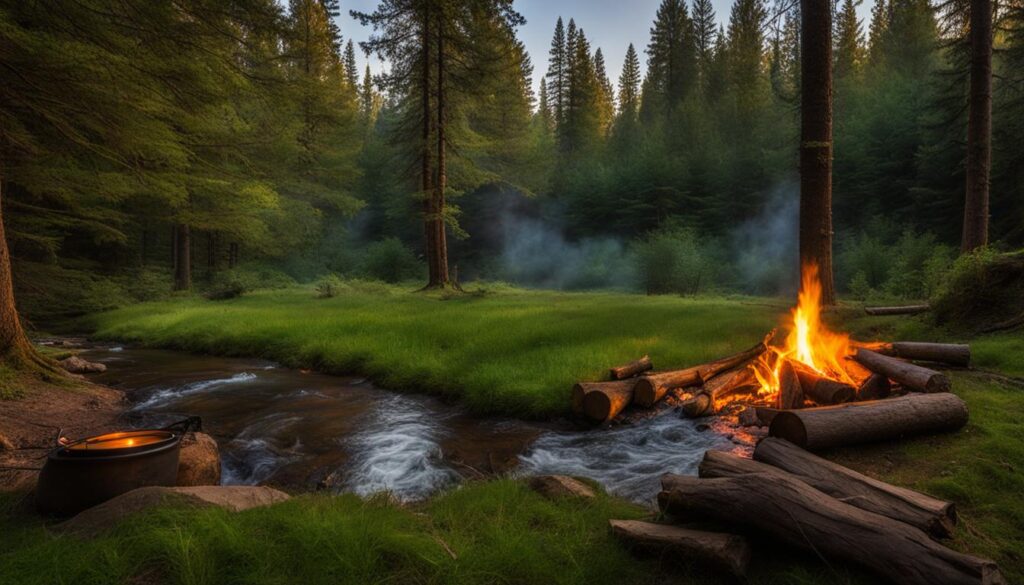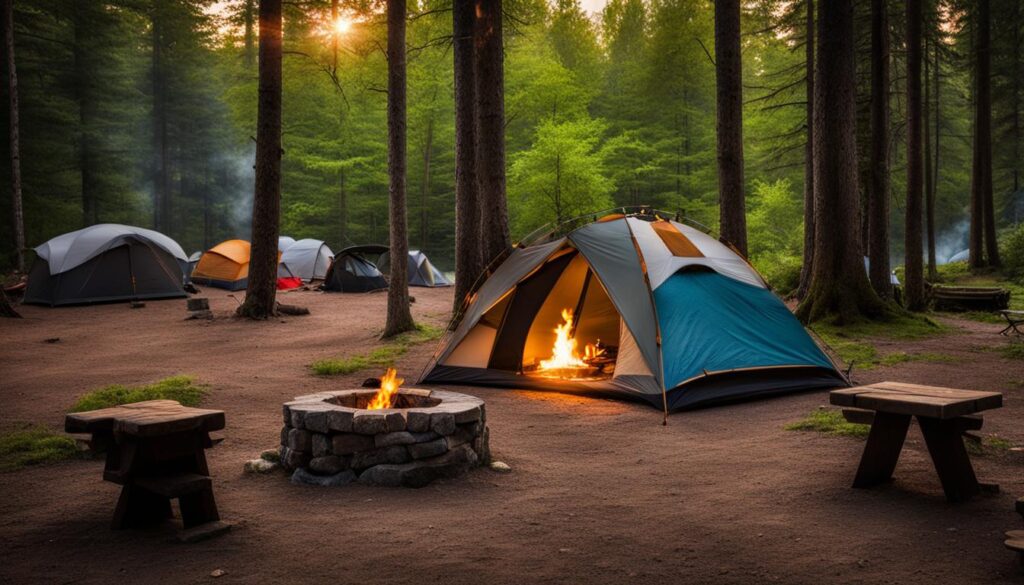Planning a camping trip can be an exhilarating experience, providing an opportunity to reconnect with nature and create lasting memories. However, a successful camping trip requires careful planning and preparation. In this comprehensive guide, I will walk you through the essential steps to plan an unforgettable camping adventure.
Whether you are a novice camper or an experienced outdoor enthusiast, these camping trip planning tips will ensure that you have all the necessary knowledge and resources to make your trip enjoyable and stress-free.
From selecting the perfect campground to organizing your gear, this guide covers everything you need to know about camping trip essentials and preparation. So, let’s dive in and start planning your next incredible camping journey!
Key Takeaways:
- Proper planning is crucial for a successful camping trip.
- Choose the right campground based on your preferences and needs.
- Research the area and discover local activities and attractions.
- Create a meal plan and organize your camping equipment.
- Pack your cooler strategically and turn your road trip into an enjoyable part of the adventure.
Types of Camping
When it comes to camping, there are several different types suited to various preferences and styles. Whether you prefer the simplicity of pitching a tent in the wilderness or the comfort of traveling in a recreational vehicle, there’s a camping style for everyone. Let’s explore the different types of camping:
Tent Camping
One of the most popular types of camping is tent camping. It offers a true outdoor experience, allowing you to immerse yourself in nature. All you need is a sturdy tent and basic camping gear to enjoy the beauty of the great outdoors. Tent camping is versatile and can be done in a variety of locations, from established campgrounds to remote wilderness areas. It’s a great option for those who enjoy simplicity and the sense of adventure.
Car Camping
If you prefer a bit more convenience and accessibility, car camping might be the right choice for you. Car camping involves loading all your gear into a vehicle and driving to a camping site. This type of camping allows you to have the comforts of your car nearby while still enjoying the outdoors. Car camping is ideal for families or those who prefer to have easy access to their camping supplies.
RV Camping
For those who crave the comforts of home while camping, RV camping provides an excellent solution. RV camping involves traveling in a recreational vehicle equipped with amenities such as cooking appliances, beds, and even air conditioning. It offers convenience and comfort, allowing you to bring the comforts of home with you on your camping trip. RV camping is perfect for those who enjoy a more luxurious camping experience.
Backpacking
For the adventurous souls who enjoy combining hiking and camping, backpacking is the way to go. Backpacking involves carrying all necessary camping gear on your back and hiking to remote areas. This type of camping requires lightweight and compact gear suitable for long hikes and overnight stays. Backpacking allows you to explore untouched wilderness and experience a deeper connection with nature.
No matter what type of camping you choose, each offers its own unique experience and opportunities for outdoor adventure. Whether you’re pitching a tent, parking your RV, loading up your car, or strapping on a backpack, camping allows you to escape the hustle and bustle of everyday life and immerse yourself in the beauty of nature.

| Type of Camping | Description |
|---|---|
| Tent Camping | A popular type of camping that requires a tent and basic camping gear. |
| Car Camping | Involves loading camping gear into a vehicle for easy access to the camping site. |
| RV Camping | Offers the comforts of home with cooking appliances, beds, and even air conditioning. |
| Backpacking | Combines hiking and camping, requiring lightweight gear for remote areas. |
Types of Campgrounds
When planning a camping trip, it’s essential to consider the type of campground you prefer. The type of campground you choose can greatly impact your camping experience and the amenities available to you. Here are four common types of campgrounds to consider:
Public Campgrounds
| Features | Locations |
|---|---|
|
|
Private Campgrounds
| Features | Locations |
|---|---|
|
|
Freedom Camping
If you prefer a more rugged and adventurous camping experience, freedom camping is an option to consider. Freedom camping allows you to camp in undeveloped areas on public land. It provides a sense of solitude and a closer connection to nature. However, it’s important to research local regulations and obtain any necessary permits before embarking on a freedom camping adventure.
Holiday Parks
For families and those seeking a wide range of facilities and activities, holiday parks are an excellent choice. Holiday parks often offer amenities like playgrounds, swimming pools, recreational facilities, and organized entertainment. They provide a fun and engaging camping experience for all ages.

Ultimately, the type of campground you choose will depend on your preferences and the kind of camping experience you seek. Whether you opt for a public campground for a rustic getaway, a private campground for more amenities, freedom camping for a rugged adventure, or a holiday park for family fun, there are options to suit every camper’s needs.
Essential Steps in Planning a Camping Trip
When preparing for a camping trip, there are several essential steps that will ensure a smooth and enjoyable experience. Taking the time to make necessary reservations, check campsite amenities, research the area, make a meal plan, and organize your equipment can make a significant difference in the overall success of your trip.
- Make a reservation: Before embarking on your camping adventure, it’s crucial to make a reservation ahead of time. This will ensure that you secure a campsite in your desired location. Many popular campgrounds fill up quickly, especially during peak seasons and holidays, so it’s always best to plan ahead.
- Check campsite amenities: Each campsite offers different amenities, so taking the time to check what’s available is essential. Consider factors such as potable water, bathroom facilities, showers, electricity, and whether pets are allowed. By knowing what resources are available, you can better prepare and pack accordingly.
- Research the area: Exploring the surrounding area of your campsite is a great way to discover activities and amenities nearby. Look for hiking trails, fishing spots, swimming areas, or local attractions. Understanding the options available will help you plan your days and make the most of your camping experience.
- Make a meal plan: Planning your meals in advance ensures that you have everything you need and reduces the chances of forgetting any crucial ingredients. Consider the length of your trip, the number of people in your group, and any dietary restrictions. Create a grocery list and pack foods that are easy to prepare and store.
- Organize equipment: Before heading out, it’s important to organize and check all your camping equipment. Ensure that your tent is in good condition and that all necessary poles and stakes are accounted for. Check your camping stove, lanterns, sleeping bags, and any other gear you’ll be using. This will give you time to repair or replace any items that may need attention.
By following these essential steps, you’ll be well-prepared for your camping trip and can enjoy a hassle-free adventure in the great outdoors.
| Essential Steps in Planning a Camping Trip |
|---|
| 1. Make a reservation |
| 2. Check campsite amenities |
| 3. Research the area |
| 4. Make a meal plan |
| 5. Organize equipment |

Tips for a Stress-Free Camping Trip
When it comes to planning a camping trip, preparing and packing your cooler is essential for a stress-free experience. One handy tip is to pre-chill your cooler with sacrificial ice before adding fresh ice. This helps maintain the cool temperature inside the cooler for a longer period. Additionally, it’s recommended to repackage your food into watertight containers to prevent any leaks or water seepage.
As you pack your cooler, remember to consider the food-to-ice ratio. Aim for a ratio of ⅓ food to ⅔ ice, ensuring that you have enough ice to keep your perishable items fresh throughout your camping trip.
Another key tip for an enjoyable camping adventure is to make the road trip part of the journey. Rather than rushing to your destination, take your time to savor the scenic routes, make spontaneous stops at vista points, and appreciate the beauty of nature along the way. Turning your road trip into a memorable experience sets the tone for your camping trip and adds an extra level of enjoyment to the entire adventure.
FAQ
How do I plan a camping trip?
Planning a camping trip involves picking a date, finding a campground, choosing a route, preparing gear, and going grocery shopping. You also need to make a reservation ahead of time, check campsite amenities, research the area, make a meal plan, and organize your equipment.
What are the different types of camping?
The different types of camping include tent camping, car camping, RV camping, and backpacking. Each type requires different gear and offers a unique experience.
What are the types of campgrounds?
There are public campgrounds, which are managed by government agencies and offer basic facilities, and private campgrounds, which are privately owned and offer more amenities. There is also freedom camping, which allows camping in undeveloped areas on public land, and holiday parks, which offer a wide range of facilities and activities for families.
What are the essential steps in planning a camping trip?
The essential steps in planning a camping trip include making a reservation ahead of time to secure a campsite, checking the amenities at the campsite, researching the surrounding area for activities and amenities, making a meal plan and grocery list, and organizing your camping equipment.
What are some tips for a stress-free camping trip?
Some tips for a stress-free camping trip include packing your cooler properly by pre-chilling it with sacrificial ice, repackaging food into watertight containers, and making the road trip part of the camping experience by taking your time and enjoying the journey.

